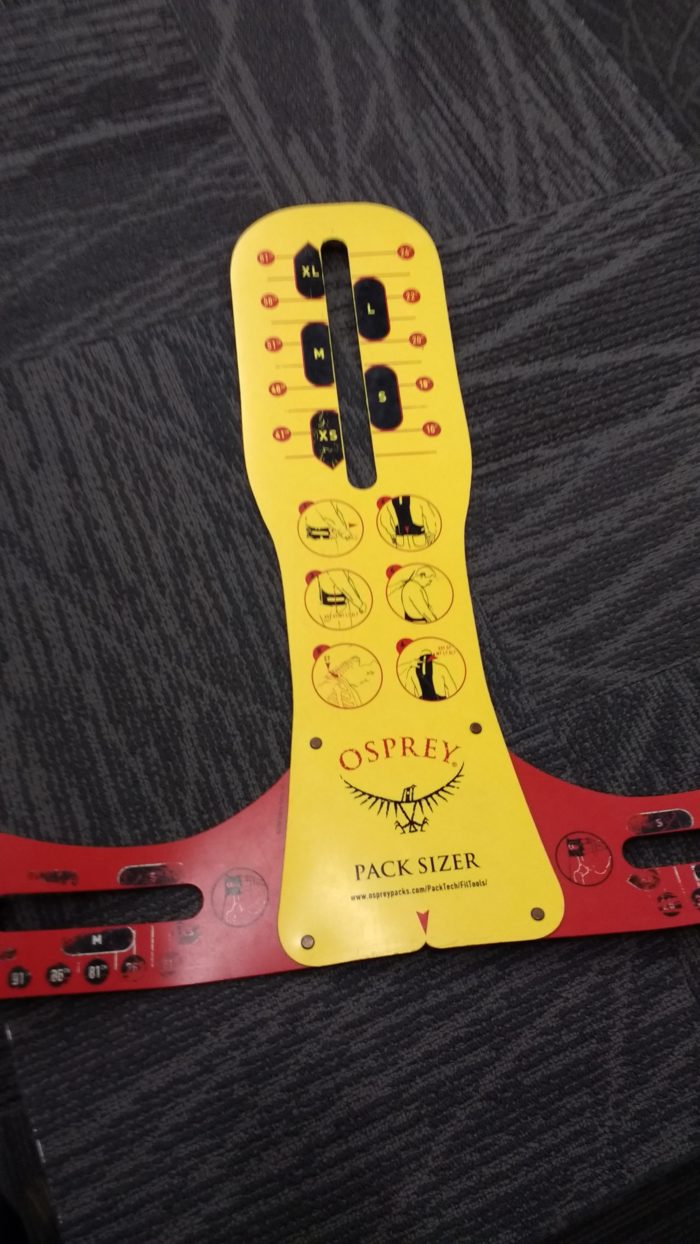Cinder-elly Cinder-elly, get fitted for a pack before hiking Cinder-elly
Since returning from the Trail, I’ve started working at an outfitter. While retail is definitely not a pleasant experience when coming back to “real life,” especially with the Christmas apocalypse upon us, it has been nice to still have this small connection to the Trail in my everyday patterns of existence. I get to talk about gear and the outdoors with customers who are at least 50% tolerable. This is of course a massive improvement over my previous retail experience with only 2-3% of the customer base being tolerable.
With the aforementioned Christmas apocalypse upon us, I’ve been rather pleased to assist several kind folks looking to make gift purchases for their more outdoor inclined loved ones. There’s also some great folks coming in hoping to take advantage of the holiday sales season to get themselves started for more outdoor adventures in the coming year. In either case, I’ve had some wonderful conversations with folks who aren’t as informed as they’d like to be and are eager to get a grasp of this whole “adventuring thing.” I love these conversations, especially since I’m not paid by commission, I get to fully indulge my inner educator and take these folks on the full tour of every question they have and every question they don’t know enough to ask. It’s rewarding and fun, and I don’t have to feel any pressure to push them towards any particular decision at that moment. Just make sure they walk out the door feeling more empowered than when they came in.
There’s one area though that I’m noticing more false expectations than elsewhere and I’d like to take some time now to address it.
That’s pack fitting.
Hoo boy. If I had a dollar for every customer who’s come in within the last month thinking they can just grab any ol pack off the wall, purchase it, and hit the trail and be fine, well… I’d probably have about twenty or thirty bucks, but that feels like a lot, especially when it’s a pet peeve of mine.
The truth is, when it comes to a pack, you need to think along the lines of the same process you use when shopping for a shoe. It’s absolutely worth your while to read reviews online and talk to folks about what they’ve purchased, and I’ll always encourage you to consider price comparisons to find the best deal because I’m an absolute cheapskate. None of these things though will replace the crucial step of actually setting foot in a store and trying the darn thing on.
For one thing, the clearest parallel in this shoe analogy is that packs come in sizes. It’s true that some packs may come as “one size fits all” with adjustable straps, especially some cheaper models, but a majority of the packs we sell come in sizes ranging from extra small to extra large. And this is not referring to the volume of the pack- that is how much stuff it can hold- rather the size of the torso that a pack is made to fit. This is essentially an expression of the measurement of the distance from your hip bone to the top of your spine. It determines how the suspension system of the pack will sit on your back, making sure that both the hip belt and shoulder straps will be in the right places in association with your body. These pack sizes are fairly broad ranges, so it can be helpful to know that some packs allow for more adjustability within those sizes than others. You may be smack dab in the middle of the Medium range, in which case you’ll be fine with most any pack of that size, but someone who tends to the shorter end of that range will need a pack that can tighten up a lot more.

This arcane device allows us to find your size. We can also usually determine your horoscope, but it almost always comes out to “Go hiking – just know it’s gonna probably rain. Buy a rain cover”
After the size has been determined, we’re going to need to see how your back pairs up with the suspension system on the pack. To continue our shoe analogy, think of how different brands of shoes will have different styles of arch supports or width cuts. These will play with different shapes of feet differently. In the same way, everyone’s back is a little different, and the different parts of the pack, from shoulder straps to the hip belt, as well as all the fun padding or mesh or lumbar supports in between, match up to you. The contours of your back may feel more comfortable with an Osprey while your similarly sized neighbor finds a Gregory pack to be infinitely more natural in the fit. This gets to a big mantra that I repeat regularly. “There is no such thing as the BEST pack. There is the best pack FOR YOU.” What works for me may not work best for you, and vice versa. That’s okay! That’s why the trail gods gave us so many different brands to choose from!
When it comes to trying the pack on, there’s another crucial step to remember. Don’t try on an empty pack. Or at least don’t rely on trying on an empty pack. You won’t go hiking with an empty pack, so you shouldn’t be making your purchase decision with an empty pack. We keep a selection of weighted bean bags that we use for this, or I’ve occasionally had a customer bring in some of their gear to try to see how the pack will feel. (CLEAN GEAR FOR THIS PLEASE)

Apparently we used to hire local children for a tuppence and a bag of coal to use to weigh the bags down, but these bean bags cry less.
This actually accomplishes two things. First, the pack will not sit on your back correctly or adjust correctly without weight in it. Think of trying on a pair of shoes without socks on. The shoe won’t sit right on your foot because it’s specifically designed to have that layer of sweet sweet Marino wool between it and your tosies. Same goes for a pack. It’s designed to have some weight in it, and if you’re trying it on without that weight present, you’re not going to be able to see how the pack will actually feel once you load it up. Second, that pack has all kinds of straps and clips on it. They’re intimidating, I know, and any outfitting associate worth their shiny gold license (I’m not supposed to tell you this, but we all get one from the guild after we complete The Initiation) will be happy to explain them to you. The gist is though that a number of them have a part to play in how the pack adjusts to your body. Again, if there’s no weight present, we’ll be adjusting those straps incorrectly. Think of them like shoelaces. Again, if you’re tying your laces up without socks on, you’re going to adjust those laces incorrectly. (note: I’m aware this metaphor fails when you get a person who prefers to go without socks, but as rare as that is, I’ve NEVER met someone who buys a pack and hikes with it empty, so roll with me here)
So once you’ve got your pack, measured to the right size, throw some weight in it and try it on, and you’re trying out multiple packs, the last thing you want to do is wander with the pack for a bit. We’ve got a decent sized store, so I’ll ask a customer to do a few laps, maybe try going up the little mock rock pile back by the shoes or climb the stairs. The goal here is to get a sense for how the pack feels with your body’s movement. It may feel fine when you’re standing still, but once you start to climb or walk, you may notice pinching in weird places or shifting awkwardly. If so, we want to identify that right away and adjust as necessary.
After hitting all of these steps, you should have a pretty good idea how you’re feeling about your purchase. It’s important to remember, this is an investment, your pack can either be your best friend on your hike, or your worst enemy. Taking the time to do this introduction right will go a long way to making this a match you’ll be happy with!
This website contains affiliate links, which means The Trek may receive a percentage of any product or service you purchase using the links in the articles or advertisements. The buyer pays the same price as they would otherwise, and your purchase helps to support The Trek's ongoing goal to serve you quality backpacking advice and information. Thanks for your support!
To learn more, please visit the About This Site page.





Comments 2
I really wanted a purple pack but there were none to be found in local stores, so I bought 2 online from a store with a very good return policy, tested them out, but wound up sending both back and heading to try packs on in the store where found one I really liked that’s not purple. I’m glad I had a chance to try the other two, though, and think buying online a good strategy if there aren’t a lot of options for stores in someone’s area as long as you are really sure about the return policy.
I have an ll bea. Pack from the mid eighties that will forever smell like vomit. I love it.